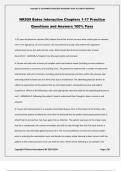Exam (elaborations)
NR509 Bates Interactive Chapters 1-17 Practice Questions and Answers 100% Pass
NR509 Bates Interactive Chapters 1-17 Practice
Questions and Answers 100% Pass
A 23-year-old physician assistant (PA) student found that she felt nervous when called upon to examine
men in her age group. On one occasion, she encountered a young male patient who appeared
embarrassed to see her w...
[Show more]
Preview 3 out of 20 pages
Uploaded on
November 11, 2024
Number of pages
20
Written in
2024/2025
Type
Exam (elaborations)
Contains
Questions & answers
Institution
Prep Tests
Course
Prep Tests
$12.49
100% satisfaction guarantee
Immediately available after payment
Both online and in PDF
No strings attached
Copyright © OLIVIAWEST2024/2025 ACADEMIC YEAR. ALL RIGHTS RESERVED




